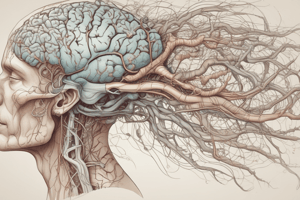Podcast
Questions and Answers
Which posture implies a destructive lesion of the corticospinal tracts within or very near the cerebral hemispheres?
Which posture implies a destructive lesion of the corticospinal tracts within or very near the cerebral hemispheres?
- Flaccid Hemiplegia
- Decerebrate Rigidity
- Decorticate Rigidity (correct)
- Externally rotated
What is the posture of chronic spastic hemiplegia when it is unilateral?
What is the posture of chronic spastic hemiplegia when it is unilateral?
- Extended
- Flexed (correct)
- Adducted
- Plantar flexed
What characterizes the posture of flaccid hemiplegia early in its course?
What characterizes the posture of flaccid hemiplegia early in its course?
- Pronated
- Adducted
- Externally rotated
- Plantar flexed (correct)
What is the posture of decerebrate rigidity?
What is the posture of decerebrate rigidity?
Which response is limited to the opposite side in flaccid hemiplegia?
Which response is limited to the opposite side in flaccid hemiplegia?
What does the posture of decorticate rigidity imply when it is unilateral?
What does the posture of decorticate rigidity imply when it is unilateral?
Which gait pattern is typically seen in basal ganglia defects of Parkinson disease?
Which gait pattern is typically seen in basal ganglia defects of Parkinson disease?
In which condition do patients drag their feet or lift them high, with knees flexed, and bring them down with a slap onto the floor, appearing to be walking up stairs?
In which condition do patients drag their feet or lift them high, with knees flexed, and bring them down with a slap onto the floor, appearing to be walking up stairs?
Which posture is characterized by bilateral lower extremity spasticity, causing the thighs to cross forward on each other at each step?
Which posture is characterized by bilateral lower extremity spasticity, causing the thighs to cross forward on each other at each step?
What type of gait is observed in corticospinal tract lesions that cause poor control of flexor muscles during swing phase, for example, from stroke?
What type of gait is observed in corticospinal tract lesions that cause poor control of flexor muscles during swing phase, for example, from stroke?
In which condition are the ankles plantar-flexed and inverted, and the affected leg extensors are spastic?
In which condition are the ankles plantar-flexed and inverted, and the affected leg extensors are spastic?
Which gait pattern involves patients advancing each leg slowly and appearing to walk through water, with compensating sway of the trunk away from the side of the advancing leg?
Which gait pattern involves patients advancing each leg slowly and appearing to walk through water, with compensating sway of the trunk away from the side of the advancing leg?
Which gait pattern is seen in disease of the cerebellum or associated tracts and is characterized by staggering and unsteady gait with exaggerated difficulty on turns?
Which gait pattern is seen in disease of the cerebellum or associated tracts and is characterized by staggering and unsteady gait with exaggerated difficulty on turns?
What type of gait is observed in loss of position sense in the legs from polyneuropathy or posterior column damage?
What type of gait is observed in loss of position sense in the legs from polyneuropathy or posterior column damage?
In which condition are the affected arms flexed, immobile, and held close to the side, with elbow, wrists, and interphalangeal joints flexed?
In which condition are the affected arms flexed, immobile, and held close to the side, with elbow, wrists, and interphalangeal joints flexed?
What kind of gait is observed when patients cannot stand steadily with feet together, whether eyes are open or closed?
What kind of gait is observed when patients cannot stand steadily with feet together, whether eyes are open or closed?




